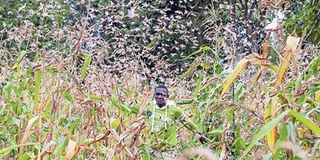Breaking News: At least 10 feared to have drowned in Makueni river
Use Big Data to guarantee food security

A man scares away desert locusts in a farm in Machakos. PHOTO | FILE | NATION MEDIA GROUP
What you need to know:
- The agriculture sector is one that can benefit most by exploring the hidden treasures in Big Data analytics, now that this agro-data is available for free to all stakeholders.
- Globally, an estimated 40 per cent of crops are lost to pests, such as the devastating maize fall armyworm, the tomato leaf miner and now the dreaded desert locust.
The current locust menace is now a real threat to Kenya’s food security efforts in the coming months.
Desert locusts are seriously interfering with the country’s ecological order, destroying the natural existence of flora and fauna, the very sources of human food.
With traditional methods that are being used to control the situation hitting a deadlock, emerging technologies offer more efficient remedies.
This must start with a collaborative digital ecosystem of sharing all agricultural data to unlock the nation’s hidden potential, an effort that could boost crop and animal production.
ACCURATE DATA
Since Kenya now boasts of the first ever free online information resource, launched recently by the Centre for Agriculture and Bioscience International (Cabi), access to accurate data should aid farmers get higher yields through better pest control.
The agriculture sector is one that can benefit most by exploring the hidden treasures in Big Data analytics, now that this agro-data is available for free to all stakeholders.
The bioprotection portal is designed to help growers and animal keepers identify, source and apply biocontrol and biopesticide mechanisms for effective results. It gives them the information to decide.
However, making this data available is not enough. The Ministry of Agriculture, farmers, vet officers, agronomists and agrovets must strengthen the capacity to analyse and act on this data in pain point areas that need it most.
To curb the dicey effects of desert locusts, for instance, live Geographic Information System (GIS) data analytics can be used to trace and track the movement of the insects in real time and devise the best way to kill them.
FAST RESPONSE
Kenya needs fast response to such unexpected situations, where data analytics play a crucial role in predicting when new pests or diseases are about to enter the country, and take proactive measures in advance.
Blending emerging technologies with authoritative content will be key to finding practical solutions to agricultural problems, especially through putting knowledge into the hands of end users.
Unfortunately, much of this knowledge is neither discoverable nor accessible and so cannot be used to benefit those who need it most. Huge reservoirs of knowledge still locked away in government traditional data silos, needs to be digitised.
Globally, an estimated 40 per cent of crops are lost to pests, such as the devastating maize fall armyworm, the tomato leaf miner and now the dreaded desert locust.
Use of chemical pesticides to fight crop pests has been proven unsustainable economically and environmentally, especially due to the hazards of climate change. The country therefore needs realtime monitoring of the performance of bio-pesticide control mechanisms to get a sustainable solution.
From a policy perspective, using digital solutions will prove a critical turning point in Kenya’s quest for food security, feeding the population with healthier and safer food.
Mr Ngila is a 4IR journalist at Nation Media Group. [email protected] @faustination




